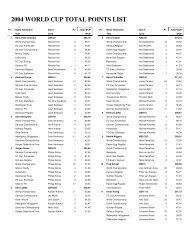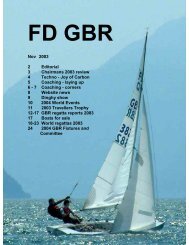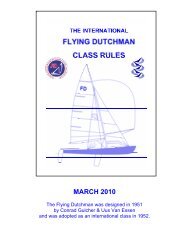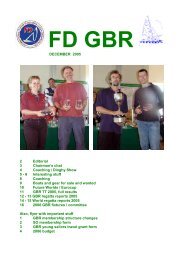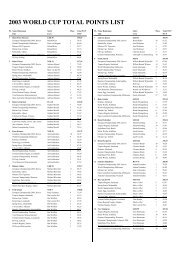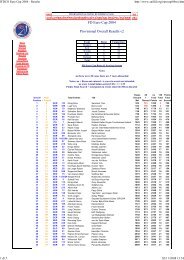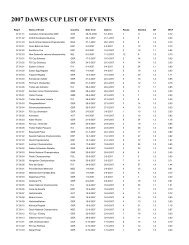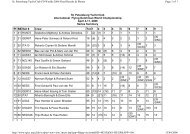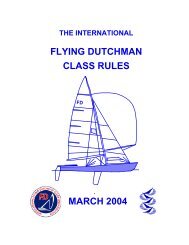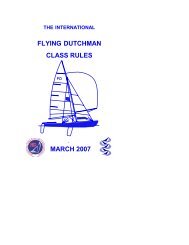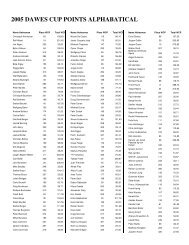March 2007 - International Flying Dutchman Class
March 2007 - International Flying Dutchman Class
March 2007 - International Flying Dutchman Class
You also want an ePaper? Increase the reach of your titles
YUMPU automatically turns print PDFs into web optimized ePapers that Google loves.
FD TellTales<br />
<strong>March</strong> <strong>2007</strong>
Contacts<br />
C - Member of British Section Committee<br />
Stephen Parry<br />
C Chairman & IFDCO VP Championships<br />
Lee-on-the-Solent contact<br />
02392 552809 Mobile 07831 296442 championship@sailfd.org<br />
Lee-on-the-Solent SC www.lossc.co.uk<br />
Tony Lyall<br />
C Hon Secretary<br />
Membership Secretary<br />
Boat Registrar<br />
01707 321633 Tonylyall@msn.com<br />
Grafham Water contact<br />
Richard Phillips<br />
C Hon Treasurer,<br />
FD UK & IFDCO Webmaster, IFDCO Councillor of Honour<br />
01590 670962 richard@sail-cd.demon.co.uk<br />
Lymington Town SC www.ltsc.co.uk<br />
Toby Dale<br />
C FD <strong>Class</strong> Promotion<br />
0770 4147783 fdbiggles@rya-online.net<br />
Lymington Town SC/ Rock SC<br />
Peter Doran<br />
C IFDCO General Secretary<br />
Oxford contact<br />
01865 726331 fdsec@sailfd.org<br />
Oxford SC<br />
Julian Bridges<br />
North Wales contact<br />
01286 830922 W 01248 351151 x2366 j.m.bridges@bangor.ac.uk<br />
David Wilkins<br />
Rutland Water contact<br />
01664 474773<br />
Rutland Water SC
Editors Reel<br />
From Dawn Barsley-Dale<br />
Well, as no one sacked me after my first attempt at the newsletter I’m back again with the Dinghy<br />
Show edition!<br />
The winter is receding and good weather is not to far away (OK, so we are the UK but you can’t<br />
blame me for wishing) and hopefully this issue will give you a little to think about as you start to<br />
remove the mothballs and ready the boat for the coming season. I have managed to persuade<br />
some of our regular contributors to put fingers to keyboard and they have kindly produced a number<br />
of articles covering boat preparation, training and the use of compasses on the racetrack. In<br />
addition we have the final event report from last season and a look ahead to <strong>2007</strong>.<br />
We are always grateful for these contributions and I’m sure if anyone has a question they would<br />
like answered I can put someone on the spot to provide an answer. If you want to send your own<br />
jottings to the newsletter, then these are also always welcome. Anyway that’s enough of me for<br />
now! Good sailing for <strong>2007</strong>.<br />
Chairmans Chatter<br />
From Stephen Parry<br />
The Dinghy Show is just about on us and Tony<br />
Lyall will have his newest, unwetted, FD on<br />
the Fastsail Stand. We are sharing with the<br />
Ospreys, 505’s and Hornets this year on a<br />
slightly smaller plot at rather less cost than last<br />
year. Come and visit us.<br />
We have finalised the fixture list for <strong>2007</strong> and<br />
hope that we have achieved a reasonable<br />
mix of sea and inland events. I will be running<br />
the Southern Area Championships at Lee-on-<br />
Solent, with my First 31.7 as committee boat<br />
and conventional triangle/sausage courses over<br />
May 26/27 with a supper in the evening.<br />
Please look out for the NOR’s for all our events,<br />
and pin the fixture list up on your notice boards<br />
at home and work!!<br />
Neil Pye is looking into the possibility of us<br />
hosting a Eurocup Event, maybe in 2008, with<br />
a view to us putting in a bid for the 2011 World<br />
Championships.<br />
I have asked Lucy to see if the 2008 National<br />
Championships could be hosted by Largs<br />
Sailing Club, the intention being to make it part<br />
of a holiday to Scotland. The 2008 European<br />
Championships will be in Croatia at the end<br />
of May/early June. As you know, this year the<br />
Worlds are in Spain at Mar Menor from the<br />
13-21 July. Rumours are that 6-7 boats from<br />
UK will be going and please note that Entry<br />
Fee payment method is through our Treasurer,<br />
Richard Phillips.<br />
There is some good news on the <strong>International</strong><br />
front in that there will be a Bulletin published
very shortly. As I said in my last note to you all<br />
Cle Jeltes is no longer able to do the jobs he<br />
used to for IFDCO and the Dutch <strong>Class</strong> has<br />
now realised the fact and taken things in hand, I<br />
think they were “in denial”!<br />
On a personal note, I am very happy to report<br />
the engagement of Vicky Parry to Steve<br />
Samuel, who happens to be 6ft 5in and 15<br />
stone and itching to have a go in Tweety!<br />
Further announcements to follow, as they say!!<br />
Well done to Dawn for producing a great<br />
Newsletter last time and see you at the Dinghy<br />
Show, or at the Lee meeting, as I will be away<br />
for the Oxford weekend. Good sailing in <strong>2007</strong>.<br />
Trapezing Times<br />
From Jamie Whitaker<br />
There has been debate recently amongst some<br />
FD crews on the perceived advantages of the<br />
continuous trapeze system. Recently Richard<br />
Scarr has been using the standard trapeze<br />
system on AUS 37 and has been vocal on its<br />
merits. I have been sceptical of this view, as I<br />
think many people were. However I now see<br />
that there is an interesting point to be made<br />
here and that the standard trapeze system can<br />
be used effectively by crews.<br />
Recently I was put in the position where I had<br />
to use the standard non-continuous trapeze<br />
system and I found it quite interesting to<br />
compare the requirements of both how I moved<br />
round the boat, up and down on the adjuster,<br />
and how the system affected the dynamics of<br />
who was in control of manoeuvres in the wire to<br />
wire tacking environment at the Midlands.<br />
Straight away the standard system eliminates<br />
some of the problems associated with the<br />
continuous system. Because you engage<br />
and disengage the hook at the height of your<br />
harness hook, you lose the possibility of the<br />
running gear on the elastic getting trapped<br />
over what is about to become the leeward side<br />
as the kicker comes across. This, if it is done<br />
in enough wind to require the crew to be out<br />
on the wire, will almost inevitably end up in an<br />
undignified swim. The absence of cross boat<br />
running elastic also afforded me more room<br />
to move about in the boat without the need to<br />
make sure you are clear of the elastic (this is<br />
more of a problem for the ungainly and clumsy<br />
amongst us… so me really).<br />
What I found surprising about the use of the<br />
standard trapeze system was that it didn’t mean<br />
that I was unable to get the genoa in as quickly<br />
as with the other system once I had got used<br />
to it. I simply had to make sure that the genoa<br />
came in quickly enough for me to be able to go<br />
out on the handle and sheet in the last 6 inches<br />
once I was comfortable out on the wire, either<br />
hooked on or still on the handle. Also surprising<br />
was that the standard trapeze somehow gave<br />
me more confidence to go lower on the wire<br />
than I would normally. I’m not sure why this<br />
would be, but I think it has something to do with<br />
being less concerned about having to have<br />
both of the J hooks at different heights making<br />
crossing the boat a more difficult procedure.<br />
Possibly only having one adjustor and a long<br />
rope on each side gave me more faith in the<br />
system not doing something unexpected<br />
reinforcing the idea that simplest is best in some<br />
cases (yes, I know that this is sacrilege in FD<br />
circles, but hey!).<br />
I think that trying the system is worthwhile if<br />
you find the continuous system to be slightly<br />
impractical for your style of sailing.
FD Midlands<br />
The <strong>Flying</strong> <strong>Dutchman</strong> class finished off the<br />
season in fine style with the Midland Area<br />
Championships at Rutland Sailing Club. Despite<br />
a gloomy forecast the rain held off to provide<br />
a range of challenging conditions over the<br />
weekend.<br />
The three races on Saturday provided<br />
brisk sailing and plenty of photo and video<br />
opportunities for the spectators! Race one was<br />
led away by Julian Bridges & Peter Hadfield,<br />
who held the lead until the first reach where<br />
regrettably they were forced to retire, as Julian<br />
was unwell. Unfortunately this proved to be<br />
the end of weekend for this team. This handed<br />
the lead to Peter Doran & Richard Phillips who<br />
comfortably held this until the finish. Second<br />
was Strangler with Simon Evance who had<br />
pulled through the fleet after an poor start. For<br />
a long time third was held by fleet light airs<br />
specialists Rosie & Neil Pye until a prolonged<br />
capsize forced them to retire as well giving third<br />
to Tony Lyall & Colin Burns.<br />
Race two saw the return of Toby Barsley-Dale<br />
& Jamie Whitaker following the repair of a<br />
broken trapeze system. The fleet spread quite<br />
quickly and place changes were few. Toby &<br />
Jamie led the fleet home followed by Strangler<br />
& Simon and Peter & Richard.<br />
The final race of the day was more open. Toby<br />
& Jamie again got away at the front chased<br />
hard by the ever consistent Strangler & Simon.<br />
Behind these two though, the battle was fierce<br />
for third. Many place changes later it was Tony<br />
& Colin who came home just in front of Keith<br />
Martin & John Lansley chased hard by Peter &<br />
Richard and Lucy Lingard & Bob Yeamans.<br />
The evening included the class AGM followed<br />
by a great meal in the club. Much to everyone’s<br />
embarrassment the video of the days antics<br />
was produced and run throughout the evening<br />
providing many laughs as people throughout the<br />
fleet showed just how not to do things!<br />
Sunday dawned much lighter and the racing<br />
became much closer. Race 4 saw the fleet<br />
tightly packed at the first mark, which was<br />
how it stayed for most of the race. The lead<br />
changed many times early on until Strangler &<br />
Simon eventually got their noses in front. This<br />
was how it remained until the penultimate beat<br />
when Toby & Jamie found a way past and found<br />
a little extra pressure on the next reaches to<br />
open a small lead that they held to the finish.<br />
Strangler & Simon came home second followed<br />
by Peter & Richard and Tony & Colin.<br />
The final race was a slightly nervy affair as the<br />
event was still quite open. Again the fleet was<br />
tightly bunched and many of the frontrunners<br />
were buried in the pack. Strangler & Simon<br />
managed to pop out quite early on and were<br />
never seriously threatened but behind them<br />
the places changed continually as the breeze<br />
started to fade and become patchy. Toby &<br />
Jamie eventually scraped their way through to<br />
second followed by Rosie & Neil then Peter &<br />
Richard.<br />
So, after a weekend of close racing, Toby<br />
& Jamies had won with the ever consistent<br />
Strangler & Simon in second. Peter & Richard<br />
came through with a well deserved third place.<br />
Also presented at this event was the travellers<br />
trophy, for more details on this see the back<br />
page.
A Young Sailors Guide to. . . racing with a<br />
Compass<br />
From Strangler<br />
A compass can be a great aid to a sailboat<br />
racer, but it must be used with caution. My initial<br />
advice would be - do not be in any hurry to get<br />
a compass. Ben Ainslie was well into his Laser<br />
career before he felt the requirement.<br />
First, learn to do well in races without one by<br />
using all the other indicators at your disposal.<br />
You should first be familiar with wind shifts<br />
and how they can magic you up the fleet<br />
and, just as easily, unceremoniously dump<br />
you twenty places down. You should also<br />
have an understanding of windshift tactics.<br />
It is not merely a case of tacking on headers<br />
[Recommended reading- Winning in One<br />
Designs by Dave Perry].<br />
Once you do have your compass here are a few<br />
tips.<br />
Location<br />
The preferred location is on the mast. Here<br />
it is close to the helms main field of visual<br />
concentration – oncoming waves and jib telltales.<br />
Hiking crews and even trapeze crews can<br />
read most types of compass on the mast.<br />
Check that no control lines will be fouled<br />
before deciding on the exact location. Flapping<br />
jib sheets have a habit of hooking round a<br />
compass so the crew must not let either sheet<br />
flap around before the start or during a tack,<br />
and always pull in slack on the lazy sheet after<br />
a tack.<br />
merely supplements these indicators. Once you<br />
are comfortable with the compass, do not use it<br />
every time. Leave it ashore for some club races.<br />
This will allow you to practice with your primary<br />
senses only, and ensure you do not become<br />
over reliant on it.<br />
Compasses will be more useful at some<br />
venues than others, eg. on a reservoir you<br />
usually have a fixed object ahead to help with<br />
orientation whereas on the sea often you have<br />
nothing ahead. At some events you may be<br />
better without a compass. I deliberately did not<br />
use one at the Datchet Symmetric Grand Prix.<br />
Racing against a hundred boats in a wok you<br />
needed to keep your eyes outside the boat and<br />
anyway, the shifts were obvious.<br />
Before going on the water think about what<br />
sort of wind you have today. Do you expect it to<br />
be steady, bending, veering or anything else.<br />
It’s better to have initial thoughts based on the<br />
weather forecast and your in-depth knowledge<br />
of wind rather than just looking at the numbers<br />
up a practice beat. If you think about the whole<br />
picture you will better understand how to play<br />
the shifts and you are more likely to understand<br />
any changes during the race [Absolutely<br />
essential reading – Wind Strategy - by David<br />
Houghton, Advanced reading<br />
Think outside the magnetic box<br />
Do not forget all the other methods you have<br />
learnt to get you round the course quickly<br />
– watching the angle of other boats, dark<br />
patches on the water, clouds, etc. The compass
– High Performance Sailing - part 1 - by Frank<br />
Bethwaite].<br />
The practice beat<br />
At a big event, get on the course early enough<br />
to sail at least part of the beat. Make a note<br />
of the numbers. How you do this is personal<br />
preference. If you can remember them in your<br />
head, OK. But if you suspect there is a regular<br />
pattern and you like making notes here is a<br />
suggested method. You will need an indelible<br />
pen or chinagraph [from art shop] and a pad or<br />
bit of deck to write on. Start your stopwatch and<br />
record the tacking angles & time, every time it<br />
changes 5°. It does not matter which tack you<br />
are on. See Diagram 1 – start from the bottom<br />
and enter the compass headings – Starboard<br />
tack on left, time in middle, Port on right. After<br />
the beat, work out the approx mean tacking<br />
angles. Add these [seen here bracketed]. Now<br />
draw a graph of the swings. You now have a<br />
visual impression of the wind. And you have<br />
set up the boat for the beat and got used to the<br />
waves etc. etc. If the wind pattern stays you will<br />
know which part of the shift you are in.<br />
The numbers game<br />
It is easy to be mesmerised or confused by the<br />
numbers on a beat, even if its an all-singing<br />
digital compass with header/lift indicators. Often<br />
there is a permanent shift during an hour-long<br />
race and you may not have time to reset the<br />
tacking angles so the indicators will become<br />
as much use as an ashtray. So, you need a<br />
simple ‘aid memoir’ to tell you if a change in the<br />
numbers is a header or a lift. The usual method<br />
is to mark + HEADER/- LIFT [ie. numbers<br />
decreasing = lift] near the compass on the port<br />
side and opposite on starboard side. This is fine<br />
but the method I use is a slight variation of this<br />
and, I believe, once you have had practice, it<br />
comes more naturally. Most sailors probably do<br />
something like this sub-consciously.<br />
The method is developed from my way of sailing<br />
Diagram 2
a compass course on a cruising yacht. So let’s<br />
look at this first. I initially devised this on a<br />
starless night passage crossing the Med when<br />
all you have to look at is the compass – it really<br />
is easy to get mesmerised by the numbers and<br />
try and turn the compass by turning the wheel,<br />
but of course the compass is static, only the<br />
boat turns. Inexperienced or tired helms will turn<br />
the wrong way.<br />
Imagine a compass card stretching across the<br />
horizon in front of you. The low numbers are<br />
on your left, the high numbers to your right.<br />
Looking at Diagram 2, the helm is trying to steer<br />
a course of 060 degrees. My [yotty] technique<br />
is to look at the compass – read the heading<br />
– 070 – and then immediately look up again<br />
and imagine the numbers on the horizon. 070<br />
is on the mast so you need to turn to port to get<br />
to 060. You now know which way to turn. Look<br />
down at the compass again once the helm is<br />
moved and make the exact correction. Without<br />
this method the tired helm usually looks at the<br />
compass, sees 60 to the left of the lubber line<br />
and thinks that turning the helm to the right will<br />
turn the card to the right …..wrong.<br />
Unlike the cruising yotty, the dinghy racer does<br />
not steer to the compass so you would just use<br />
the first part of the technique.<br />
Diagram 3 illustrates a boat beating on port.<br />
If the numbers decrease on the compass you<br />
must be turning left ie. lifted. Yes it’s as simple<br />
as that. OK you say, but what if you are sailing<br />
due North – the high numbers will be on the left.<br />
Yes, but I said ‘imagine a compass card in front<br />
of you’. Hopefully you can imagine 340, 350, 00,<br />
10, 20.<br />
You may not be very impressed by this method,<br />
but after using it a few times you should find it<br />
comes naturally and is user friendly when the<br />
pressure is on.<br />
Some tactical compasses do not display the<br />
usual compass card ie. 0 to 360 degrees but<br />
show 0 to 20 or similar. It’s a long time since<br />
I used one of these but the above principles<br />
can be applied. A good article about such<br />
compasses can be found at http://www.<br />
roostersailing.com/articles/compass_article.htm<br />
The beat is not the only fruit. A compass has<br />
many uses other than helping you up the beat.<br />
Here are some.<br />
On a regatta course, if you get a chance, record<br />
the bearing of each downwind leg before the<br />
start. As you round each mark, if you cannot<br />
see the next mark a quick look at the compass<br />
will tell you if the boats ahead [hopefully not<br />
too many] are high or low. Do you know what<br />
is the highest angle to the wind you can carry a<br />
spinnaker? This could be useful information as<br />
you lead round the windward mark onto a tight<br />
reach.<br />
Diagram 3
Lymington Town Sailing Club<br />
Hamble Scramble - 12-13 May<br />
2 races over 2 days<br />
Saturday - Lymington - Calshot<br />
Sunday - Calshot - Lymington<br />
Dinghies can be left at Calshot o/night (trailers will be<br />
transported) and camping is available<br />
More information at www.ltsc.co.uk<br />
FREE<br />
ENTRY<br />
Take a bearing of the start line by lining up the<br />
two ends and sailing towards them in transit<br />
but note that a current may modify your sailing<br />
angle in order to keep the ends in transit. If<br />
you suspect this, sight along the centre-line of<br />
the boat to the transit and take a reading [The<br />
current may modify line bias considerations but<br />
is not covered in this article], then shoot head<br />
to wind – boat near stationary - so there is no<br />
apparent wind, boom and jib on the centreline,<br />
read bearing. Calculate any bias on the line,<br />
then decide if you want to go for the biased end<br />
or whether other factors are more important. If<br />
you get a chance to recheck the wind angle in<br />
the last three minutes, do it.<br />
On the run you will be trying to sail as low to<br />
the mark as you can. The compass will indicate<br />
shifts and help decide which gybe to take. Most<br />
sailors find compass use on the run far more<br />
difficult than the beat so make sure you practice<br />
this leg.<br />
And one of the best uses of a compass - as you<br />
beat upwind and look outside the boat to gather<br />
information – then look back at the tell-tales you<br />
often get that sixth sense that you have been<br />
headed. Look at the compass – Nope!<br />
©StranglerHornet<strong>Class</strong>Association2006
Slow Speed Boat Handling<br />
From Toby Barsley-Dale<br />
One of the biggest weaknesses of the British<br />
fleet when faced with international competition<br />
is our ability to get a decent start. We are line<br />
shy and more often than not in the second<br />
rank of a start if not worse. On the occasions<br />
someone does get a good start their finishing<br />
position is always markedly better than the<br />
average.<br />
To get a decent result at the end of the race you<br />
have to start well so that you dictate your own<br />
race rather than having it dictated by others.<br />
Unfortunately due to the small numbers of boats<br />
at UK opens we all revert to classic club racing<br />
starts and sail timed runs down generously<br />
sized start lines meaning we get no opportunity<br />
to practice the big fleet skills of holding position<br />
on a crowded line and general slow speed boat<br />
handling.<br />
On the rare occasions we do go and practice,<br />
the only time we go slowly is leaving and<br />
arriving at the beach. However no matter how<br />
much tacking, gybing and boat speed practice<br />
you do, if you start badly you will never be as<br />
fast as the guys with good starts as they will be<br />
in clear air and be able to pick their shift!<br />
The idea here is gain confidence in our ability to<br />
sail the boat slowly in confined spaces and with<br />
the genoa furled. Hopefully with a little practice<br />
we will be happier to push into the front rank<br />
and fight for the position we need for when the<br />
gun goes.<br />
The exercise!<br />
OK, all you need for this exercise is one mark.<br />
The object of the exercise is to sail as close
to the mark as closely as possible throughout<br />
the exercise. This will make us think about how<br />
we slow a boat down and sail backwards and<br />
will highlight what happens when we change<br />
speed by sheeting on, sheeting off, pushing<br />
the boom out and healing the boat. All of these<br />
thing influence what the boat is doing and with<br />
practice we can make the boat perform some<br />
very clever tricks.<br />
should be level with the mark.<br />
Get the boat to start moving backwards past the<br />
mark and turn the transom away so you are on<br />
port tack. Stop the boat again. The bow should<br />
be level with the mark.<br />
Sheet on and sail passed the mark leaving it to<br />
port this time and stop head to wind. Again the<br />
transom should be level with the mark.<br />
I am not going to attempt to describe what<br />
happens when we do all the different<br />
permutations with sails and heel, it is far better<br />
to discover this on the water. Suffice to say even<br />
in an FD that is stationary with headsail furled<br />
you still have a surprising amount of control.<br />
Right, the exercise itself<br />
With headsail furled slowly approach the mark<br />
on starboard leaving the mark to port. Round<br />
up head to wind and stop the boat. The transom<br />
Get the boat to start moving backwards past the<br />
mark and turn the transom away so you are on<br />
back on starboard tack. Stop the boat again.<br />
Once again bow level with the mark.<br />
Sheet in and accelerate away.<br />
Apparently it is possible to do this with<br />
the boat just about within one length at all<br />
times…………….<br />
Sounds simple doesn’t it! Have fun!<br />
Preparing for the season<br />
From Julian Bridges<br />
I reckon there are three things that need to be<br />
prepared before the beginning of each season.<br />
In addition to the boat, these are the team, and<br />
also the plan for the year.<br />
Ok, the boat first<br />
There are any number of sources for boat<br />
preparation, so we are not going to look at the<br />
minutiae of the job, I just want to develop the<br />
concept. I am sure that for some FD sailors the<br />
numbing fear of an MOT test is a long forgotten<br />
emotion, but that is what we need to emulate.<br />
Draw up a list of the things that need to work<br />
properly on the boat, breaking it down into the<br />
different components – hull, foils, spars, sails,<br />
and not forgetting the infrastructure – trailing<br />
gear, covers, etc. For each component, list<br />
everything that you have ever broken or have<br />
heard of breaking or being damaged. Go out<br />
to the boat with the list in hand, and check all<br />
the weak points. In the space that you have<br />
left after the list points you write the other<br />
defects you find. This is easy, boat maintenance<br />
without getting dirty! Once you have completely<br />
checked the boat, you will have compiled a job<br />
list. Then it’s just a matter of getting down to<br />
doing it!<br />
A couple of examples:-
Rudder Assembly<br />
Pintles to stock<br />
good, tight, but safety clip bent, REPLACE<br />
Tiller into stock<br />
slight play, sort it, how?<br />
Extension joint<br />
beginning to tear, REPLACE<br />
Genoa<br />
Luff wire<br />
good both ends, tack shackle pin end sharp<br />
Luff lashing<br />
worn, REPLACE<br />
Stitching<br />
Slight wear at tack from furling, tape<br />
I have taken for granted a couple of things,<br />
firstly that everything will have been washed<br />
down properly at the end of the year, even if you<br />
last sailed on fresh water, Rutland still has pretty<br />
good mud, and mud is made of grit. Secondly,<br />
every fitting will be individually checked and<br />
given a good squirt of quality lube or replaced,<br />
and every string and shockcord will be checked<br />
throughout its length for wear, including inside<br />
the boom, under the decks, etc.<br />
I also like the boat to look good, so old stickers<br />
come off, with a hairdryer to soften the glue, all<br />
the calibration marks are redone, the old ones<br />
removed, and all the insulating tape is the same<br />
colour.<br />
I blew the Nationals for Pete by falling out the<br />
boat. There was nothing wrong with the toe<br />
strap lifting shockcord and I think I may have felt<br />
a bit of the fall of the mainsheet against my foot<br />
and sat out against that. I broke the extension<br />
by hanging on to it too long, but worse, the<br />
unnatural load transmitted to the tiller and broke<br />
it off in the stock. Looking at it afterwards, there<br />
was freshly broken metal round only about a<br />
third of the tube, the rest had cracked previously<br />
and was grey with corrosion. This year, the<br />
visual check of the top of the tiller at the load<br />
point (the most forward rivets to the stock) will<br />
be replaced with a visual check underneath<br />
the tiller as well, and then, putting the stock in<br />
the vice and wrenching the tiller about. Had I<br />
spotted the damage that must have been there<br />
at the beginning of the season we would only<br />
have had to bin one race at the bloody National<br />
Championships rather than two.<br />
We are not rounding Cape Horn in winter, nor<br />
are we about to engage with the Frenchies,<br />
but we sail in big breezes and we fight in close<br />
quarters. So, to help build some confidence<br />
when racing, just make sure it works. He<br />
that walks the dinghy park showing off the<br />
broken bits is really only showing off his<br />
incompetence at boat maintenance, IT IS ONLY<br />
SEAMANSHIP.<br />
The team is the second facet<br />
Us weirdos are intending to spend our<br />
leisure time in an intimate situation which<br />
is competitive, often tense, and can appear<br />
dangerous. You have to have trust in and<br />
have mutual support for, each other. One of<br />
the best ways to develop this is with open<br />
communication and, I think it’s called, a no<br />
blame culture. Talk to each other and fighting<br />
within the boat will be replaced with beating the<br />
other boats. This all may sound rather green,<br />
hippy, and Guardian reading, but I’ll put up a<br />
box of Tempranillo to say that the RAF (just who<br />
could I be thinking of?) even if not in the wider<br />
organisation, would encourage this within the<br />
individual helicopter.<br />
Everyone has differing strengths, and if the<br />
dice roll to push the weaker limits of your team<br />
mate, try to remember that they have their<br />
strengths too. Pete will never be the Billy Elliot<br />
of North Wales but he has the mind and hands<br />
of an engineer and the tenacity in adversity of<br />
a trench soldier. Corin has never got the hang<br />
of putting the cover on or using a phone, but
the explosive power and precise balance were<br />
very welcome. His testosterone, petrol, and red<br />
bull/vodka crazed attitude also meshed very<br />
well with the laid back approach from the back<br />
of the boat. Cathy, unlike the other two, is never<br />
at her happiest as 25 knots rattle the clubhouse,<br />
but the concentration while trimming in light airs<br />
is incredible, there is always water and food,<br />
and we are always at the start area on time.<br />
We have done, in the training weekends,<br />
various exercises to see what we need to<br />
work on within teams, and again there are no<br />
end of sources to this, and it all seems to be<br />
adapted from management bollocks anyway,<br />
so get on with the SWOT and the SMART, and<br />
the dartboard, cos that’s the method that has<br />
led GBR to Olympic domination in the last two<br />
games. Again, it’s a pleasant way of preparing<br />
for the season, which can involve eating and<br />
drinking as well as talking. Make a deal, one<br />
studies the RRS, the other gets to grips with<br />
windshift prediction and both agree to practice<br />
reach to reach gybes together.<br />
Last chance, (early Feb) final few days, start<br />
getting fit. Swim, gym, bike, jog, run, salsa,<br />
yoga, laser. I can’t do what I did twenty years<br />
ago but its only cos I haven’t bothered. Chris<br />
Hogan (mid-late fifties?) has just won his sixth<br />
consecutive Squib Nationals and he is in the<br />
gym for two or three sessions a week.<br />
You can’t win without a boat, but it’s not the boat<br />
that wins, it’s the people in it.<br />
The plan<br />
The only year that we have ever had a<br />
proper plan was 2005, when there were three<br />
objectives and we actually achieved them.<br />
Again it’s really all RYA-speak, outcome goals<br />
and process goals, decide what you want to do<br />
and what you need to do to get you there. Cath<br />
and I never actually achieved the only goals we<br />
ever set, to be in the top half of the international<br />
fleet and to be top mixed boat. Those were our<br />
outcome goals and there should have been<br />
more process goals to get there. Let’s have an<br />
ambitious but realistic outcome or dream goal<br />
and once you have an outline, colour it in with<br />
paint by numbers process goals. We need to<br />
go to this list of events, we need to use every<br />
club race possible as training in addition to<br />
slots for the dedicated training sessions on the<br />
weaknesses the club racing throws up. We<br />
need to set time aside for fettling sessions,<br />
as well as time for evaluating the new sails.<br />
It’s suddenly all got so bloody complex that<br />
we need regular ‘sit down and think’ planning<br />
meetings but we can have them in the pub,<br />
although they will be in a quiet corner and with
something halfway towards an agenda. Finally<br />
we need to sort the logistics. Tony Lyall is the<br />
one for this. I’m sure he has already booked<br />
ferries and hotels and knows at which Autohof<br />
he will stop for a pee during each weekend in<br />
September. At least let’s get the entries in for<br />
the main events before the late entry penalties<br />
and book your leave, including the relevant<br />
Friday afternoons and make Monday morning<br />
at work fit around the fact that you arrived home<br />
at midnight, having driven 300 miles, after three<br />
races at sea in a force five.<br />
Having an agreed plan fits into the<br />
communication bit above, it doesn’t have to be<br />
the Schlieffen plan, in fact it must be flexible<br />
to change as the season progresses. It’s up to<br />
each team to decide how detailed they want<br />
to make it, but you don’t need to be too casual<br />
about campsites at Bala on a bank holiday.<br />
Being organised is not the same as being anal!<br />
Results - Come & Join Us!<br />
From Richard Phillips<br />
Whether you are an owner of an FD, helm<br />
or crew, one of the main benefits of being a<br />
member of the FD class is the opportunity<br />
to visit and sail in many venues in the UK,<br />
Europe, Australasia and the Americas. The FD<br />
is welcomed around the world. In the UK, we<br />
have three main annual regattas – National<br />
Championships, Midland Area Championships<br />
and Southern Area Championships. Do not be<br />
put off by the word Championships – anybody<br />
is welcome so come and join in – contact the<br />
organiser or committee member for assistance.<br />
Go to www.sailfd.org/gbr for<br />
a full events calendar<br />
outside Europe then there is also a European<br />
Championship. These are also friendly events<br />
and open to any member of IFDCO. However<br />
good or experienced you are, there will be good<br />
competition and many learning experiences.<br />
Each country organises its own events and<br />
there are many major FD regattas in Europe.<br />
Each year IFDCO promotes a selection of<br />
these events to form part of the FD Euro Cup<br />
and many other events are also included in the<br />
Dawes Cup.<br />
In addition there are a number of other open<br />
meetings in the UK that are included in the FD<br />
UK Travellers Trophy. These are informal events<br />
and a good chance to experiment with different<br />
boats, crew, helms, sails, masts, rig settings,<br />
etc. Treat these events as learning experiences.<br />
The FD as a member of Fastsail and so FD<br />
members are entitled to participate in Fastsail<br />
events like the annual Symmetric Grand Prix.<br />
IFDCO<br />
The international FD <strong>Class</strong> organises an annual<br />
World Championships and if the Worlds are<br />
With the Worlds in Spain in <strong>2007</strong> and New<br />
Zealand in 2008/9 and a Europeans in Croatia<br />
in 2008 – now is a great time to join the <strong>Class</strong><br />
so do not be shy – come and join in!<br />
UK Travellers Trophy<br />
2006 proved to be a very close event with 4<br />
teams having a chance of winning at the start of<br />
the last event, the Midland Area Championship.<br />
Tony Lyall & Colin Burns were in the lead with<br />
the highest points but were already counting 5<br />
events so had to improve on their worst result<br />
to increase their points score. Lucy Lingard was<br />
three points behind and also counting 5 events.
Peter Doran & Richard Phillips and Julian<br />
Bridges & Peter Hadfield had many very close<br />
races during the year and were on equal points.<br />
Each would be counting five attendance points<br />
as they had only attended four events each.<br />
Julian & Peter blasted away into an early lead<br />
in the first race and then retired after capsizing<br />
with Julian feeling very weak from an illness.<br />
Peter & Richard went on to finish third in the<br />
event ahead of Tony and Lucy which enabled<br />
them to regain the Travellers Trophy.<br />
Travellers Trophy <strong>2007</strong> - Scoring System<br />
Any boat starting at least one race in a<br />
qualifying event shall score 5 point plus the<br />
number of boats helmed by members of the<br />
British Section that it beats in the overall results<br />
in that event. Boats attending and entering an<br />
event but not starting a race will score 5 points.<br />
Boats not attending an event or attending but<br />
not entering an event will score 0 points.<br />
<strong>2007</strong> - best 4 events to count<br />
Tie Breaker<br />
In the event of a tie, the boat that travelled<br />
the furthest miles from its home club to attend<br />
events in the UK shall be judged the winner.<br />
If two or more boats on equal points travelled<br />
equal distances in the UK, they shall be ranked<br />
in order of the number of events attended so<br />
UK Travellers Trophy Results<br />
that the boat attending the highest number of<br />
events is ahead.<br />
Extracting Results from SGP/Handicap<br />
Races/Pursuit Races<br />
FD’s qualifying for Travellers Trophy will be<br />
scored in the order that they appear in the<br />
overall results of that event using the scoring<br />
system for that event.<br />
Bala July - Long distance race & Pursuit race<br />
are run by club as separate events - both races<br />
will count based only on FD results<br />
Qualifying Events <strong>2007</strong><br />
Event 1 Oxford Tankards<br />
Event 2 Southern Area Championship - Lee<br />
on the Solent<br />
Event 3 Bala July - Long Distance Race &<br />
Pursuit Race - both to count based<br />
only on FD results<br />
Event 4 Open National Championships<br />
- Felixstowe Ferry<br />
Event 5 Midland Area Championship<br />
– Rutland<br />
Note<br />
Any FD sailor may nominate additional events<br />
for consideration by the Committee as a<br />
qualifying event.<br />
Euro Cup events <strong>2007</strong><br />
1 Peter Doran & Richard Phillips 45<br />
2 Tony Lyall & Colin Burns 41<br />
3 Julian Bridges & Peter Hadfield 40<br />
4 Lucy Lingard & crew 36<br />
5 Rosie Pye & Neil Pye 28<br />
6 Toby Barsley-Dale & crew 22<br />
7 Jon Williams & crew 22<br />
8 Keith Martin & John Lansley 16<br />
9 Alex Rogers and Martin Hattersley 6<br />
10 Bill Oliver & Neil Sexton 5<br />
Altea Cup<br />
Kiel Week<br />
European<br />
Champs<br />
Marina Preis<br />
Conrad Gulcher<br />
Altea<br />
Kiel<br />
Kiel<br />
9-11 Feb<br />
17-25 June<br />
Neusiedlersee<br />
22-29 July<br />
Riva Del Garda<br />
31 Aug-2 Sep<br />
Loostrecht<br />
7-8 October



